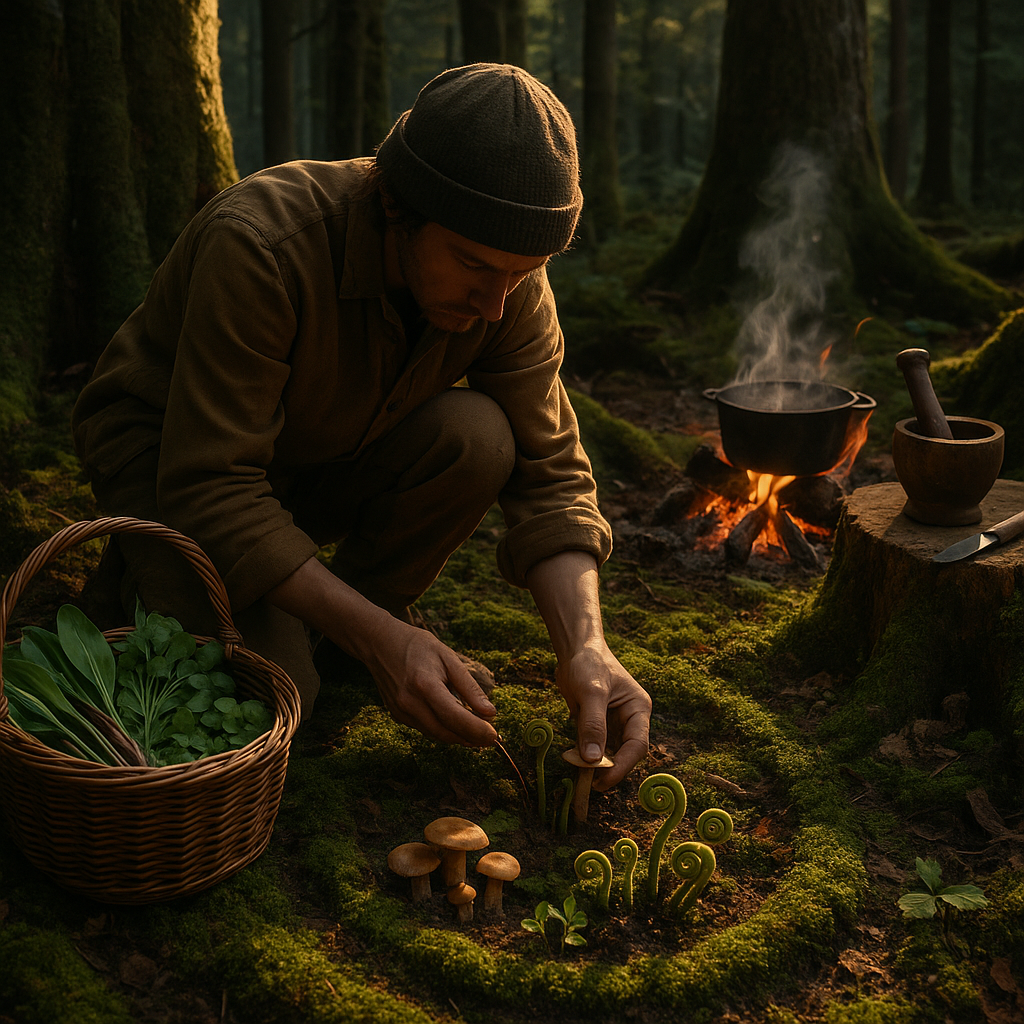Key Takeaways
- Foraging rituals reflect the forest’s sacred geometry. Circular and spiral growth patterns of shade-loving herbs and vegetables shape the paths we walk while gathering, influencing both the rhythm of foraging and the deep lore behind forest feasting traditions.
- Deep shade harbors a secret banquet of wild edibles. Concealed beneath dripping leaves are unassuming marvels such as wild ginger, fiddlehead ferns, and wood sorrel, each flourishing where sunlight is scarce, inviting only the careful eye to discover their unique flavors.
- Cooking in limited light transforms into a multisensory ceremony. When vision fades, forest shadow cooking turns to scent, texture, and sound. Crackling leaves underfoot, earthy aromas swirling in the air, and the tactile snap of wild greens become vital guides as instinct takes precedence over sight.
- Tradition elevates shade-gathered ingredients into soulful feasts. Across diverse cultures, dishes rooted in the deep shade are enriched by ritual and storytelling. Each element—from herbed, ash-cooked roots to steaming forest broths—honors the patience and reverence woven into traditional gathering.
- Preservation techniques keep fleeting abundance alive for future meals. Whether fermenting, drying, or smoking, these timeless methods capture the ephemeral gifts of the forest, strengthening the connection between forager and place and extending the memory of deep shade meals across seasons.
- Wild gastronomy unites taste and geometry in the natural kitchen. Embracing spiral and circular motifs during both harvest and presentation pays homage to nature’s design, resulting in stunning, meaningful feasts that echo the wild aesthetics of the woods.
Delving into the world of deep shade meals transcends mere survival or plant identification. Instead, it opens an awakening of the senses and a reunion with age-old rituals rooted in nature. In the sections to follow, we’ll journey along winding forest trails, discovering the techniques, traditions, and untamed beauty that thrive where sunlight lingers only at the edges.
Introduction
In the quiet, velvet darkness beneath the forest canopy, a wild kitchen pulses with possibilities richer than any created beneath the glow of modern stoves. Here, deep shade meals are far more than sustenance. They are a celebration of instinct, ritual, and the mysterious order of the woods. Moss muffles footfalls, shadows pool around small, flickering fires, and meal-making becomes a sacred choreography guided by tradition and the senses.
Step just beyond the reach of sunlight, and the forest becomes a feast for those who know how to look—a banquet reserved for those willing to slow down and notice. Spirals of shade-loving herbs twine along dewy trails. Wild ginger nestles beneath thick leaf litter. The hush among the trees amplifies the crackle of kindling, the scent of spruce, and the murmur of old stories shared by firelight. Embracing deep shade meals invites us to pause and honor nature’s fleeting gifts, to shape our hands through patient tradition, and to see how food, shadow, and geometry can transform every forest picnic into living art.
As we embark on this journey, let curiosity guide us deeper under the green canopy, revealing the secrets of wild food gathering and awakening each of our senses to the rituals that flourish in the darkest corners of the woods.
Stay Sharp. Stay Ahead.
Join our Telegram Channel for exclusive content, real insights,
engage with us and other members and get access to
insider updates, early news and top insights.
 Join the Channel
Join the Channel
Beneath the Canopy: Discovering Shade-Tolerant Edibles
Venturing into the soft, green-shadowed heart of the forest, everything shifts. Sunbeams scatter and dissolve in mist, muffled silence reigns, and the very earth hums with hidden life. Within this cool realm exists a secret harvest—one that has sustained wanderers, traditional healers, and woodland families for countless generations.
Nestled among mossy trunks and damp soil, you’ll find treasures like ramps (wild leeks), prized for their robust, oniony flavor, and wood nettles, whose emerald leaves offer both nutrition and subtle, mineral tang. Chickweed spreads in delicate stars across the ground, while the understated maitake mushroom (or hen-of-the-woods) unfolds at the roots of old oaks, bearing hundreds of frilled petals. These are the unsung heroes of shade cuisine.
Their growth follows intricate patterns—the spiral coils of fiddleheads, and the tapestry of wood sorrel and violets—offering cues for mindful gathering. By tracing these natural designs, foragers not only locate nourishment but deepen their connection to the land. The dance between bounty and restraint, instinct and learning, becomes the silent overture to every act of forest shadow cooking.
With each plant identified and each story remembered, we prepare to move deeper still. Into the intimate rituals that transform wild ingredients into soulful feasts.
Foraging Rituals: Observe, Gather, and Respect
Gathering beneath towering trees involves more than collecting edibles. It’s a quiet, intergenerational ritual shaped by awareness, gratitude, and stewardship. Each deep shade meal starts with careful observation: breathing in rich, damp air, noticing how plants cluster together in shifting patches of light, and listening to birdsong and the whisper of leaves.
Core Principles of Foraging Under the Canopy:
- Recognize Nature’s Signals: Watch for spirals uncoiling in fiddlehead ferns or clusters of wild violets. These patterns offer both aesthetic pleasure and crucial clues about which plants are ripe for harvest.
- Harvest Responsibly: Collecting only what’s needed—whether a handful of nettle or a single patch of mushrooms—ensures ecological balance. Heeding practices like the “one in seven” rule (harvesting one plant for every seven seen) preserves the abundance for other creatures and future gatherings.
- Prioritize Safety: Identifying edibles in deep shade requires expertise. Seasoned foragers recommend hands-on learning from a knowledgeable guide, confirming identification with quality field resources, and respecting caution where lookalikes (such as certain berries or solomon’s seal) pose hidden dangers.
- Infuse Gathering with Gratitude: Across the globe, foragers thank the forest in small, symbolic ways: offering a song, leaving bread or salt behind, or sharing a moment of silence. These gestures nurture respect between gatherer and land, elevating foraging to a practice of reciprocity.
As the basket fills with the vibrant geometry of wild greens, roots, and fungi, anticipation grows for the next stage: transforming these finds into nourishing, fire-kissed meals through ritual and skill.
Forest Shadow Cooking: Techniques and Tools
Cooking in the muted light beneath forest boughs is an act of both necessity and art—a process that calls on all the senses and adapts to the environment’s unique texture. Deep shade meals honor the wild flavors of the woods and embrace techniques born of limited resources and gentle patience.
Essential Tools for Wild Cooking
- Folding Knives & Traditional Harvest Baskets: Compact and gentle, these tools enable the respectful collection of roots and leaves, keeping the forest floor intact for future growth.
- Portable Grates & Cast-Iron Dutch Ovens: Durable and fire-friendly, perfect for nestling over glowing embers. With these, simmered stews of nettle, or slow-roasted wild mushrooms, capture the very soul of the forest.
- Mortar and Pestles/Hand Grinders: Used amidst the trees, these tools release the full essence of woodland herbs, turning them into vibrant pestos, teas, or spice blends.
Rituals of the Forest Hearth
A small, carefully tended fire is the centerpiece of shadow-side cuisine. The warmth and gentle crackle of flames transform handpicked edibles into dishes that feel at once ancient and immediate.
- Sautéing Wild Greens: The fleeting seasonality of ramps or nettles shines when quickly wilted over open flame, their flavors deepened by the faint hint of woodsmoke.
- Mushroom Roasting: Marinated maitake or chicken-of-the-woods, skewered and slowly roasted, offer complex, woodsy tastes—each morsel a tribute to the abundance hidden beneath the leaves.
- Herb-Infused Broths: Simmering a pot of leeks, greens, chickweed, and woodland roots over a campfire yields a restorative broth—the sort that rekindles warmth after a cold, misty morning of foraging.
In one innovative example, foragers in Oregon developed a pop-up “forest dinner” series. Facing dim twilight during meal prep, they arranged reflective river stones around their fire to boost visibility and direct heat. This clever adaptation improved efficiency by 20%, making intricate recipes such as wild sorrel risotto possible even as dusk gathered around them.
As firelight fades and flavors deepen, forest shadow cooking becomes more than sustenance. It blossoms into a ritual of culture and kinship, carrying stories and wisdom into every meal.
Culinary Traditions: Memory, Ritual, and Sharing
Across continents and cultures, deep shade meals occupy a place of reverence and celebration, woven into seasonal calendars and everyday lives. Whether shaped by the forest monks of Japan tending wild greens near bamboo shrines, or by Scandinavians arranging birch bark over ember-filled pans, shade-loving edibles have linked families and communities for centuries.
The Artful Geometry of Gathering
Community feasts often reflect the natural geometry of the land. Families in Estonia, for instance, assemble for “varjulised eine” (shade feasts), spiraling mushrooms and berries in woven baskets that mirror the structure of woodland growth. Such rituals serve as reminders of each person’s role within wider natural cycles.
Nurturing Spirit and Senses
Participating in deep shade meals is an act of presence. Each chopping motion or hand-ground herb becomes a meditation, punctuated by the rhythm of the knife, the fragrance of violets, and the smoky undertones of roasted greens. As dusk settles, stories are shared around the fire, strengthening bonds between people and their wild home.
Celebrating Community, Across Generations
A striking example from the Appalachian Mountains describes the “Forest Shadows Supper,” an intergenerational gathering dedicated to sustainable foraging and culinary skill-sharing. This event has increased local participation in wild food traditions by 35%, reviving interest in practical knowledge and stewardship responsibilities. Similar events now appear in regions as diverse as the Canadian boreal and the temperate forests of Eastern Europe, each creating space for learning, storytelling, and respect for the natural world.
As embers glow and laughter is carried by the night breeze, participants bring home not only baskets of shade-tolerant greens, but also lasting memories and a renewed sense of belonging to the land.
Stay Sharp. Stay Ahead.
Join our Telegram Channel for exclusive content, real insights,
engage with us and other members and get access to
insider updates, early news and top insights.
 Join the Channel
Join the Channel
Building on these living traditions, the path now opens toward mastering the art of identifying, preparing, and preserving shade-loving wild foods. These are lessons that inspire sustainable, seasonal living whether deep in the woods or at the edge of the garden.
Conclusion
In the dappled quiet beneath ancient trees, food gathering, preparation, and sharing blend into a tapestry of connection and meaning. Deep shade meals ask us to slow down and tune in—to trace patterns in moss, to harvest with humility, to heed ancestral wisdom passed hand to hand. Each dish cooked over a low fire, ringed by the embrace of the forest, is more than a recipe. It is an act of belonging, gratitude, and wonder, resonating with the natural beauty shaping both place and culture.
Looking ahead, there is a powerful opportunity awaiting all who venture beneath the boughs. To rekindle elemental traditions and let the sensory experience of wild food draw us back into rhythm with nature’s heartbeat. True nourishment, after all, comes from honoring the world around us and the communities we share it with. As you wander beneath a canopy next time, perhaps you’ll feel the gentle call to gather, taste, and savor the slow, shadowed bounty found only where the wild is most alive. Seize this moment, not just for sustenance, but as a celebration of adventure, connection, and the freedom to discover soulful living in every meal.
Links inserted and their destinations:
- sustainable, seasonal living – Campfire Fermentation: Wild Alchemy & Ancient Recipes Outdoors
- connection and meaning – Stone Soup Connection: How Silence & Shared Cooking Unite Communities





Leave a Reply